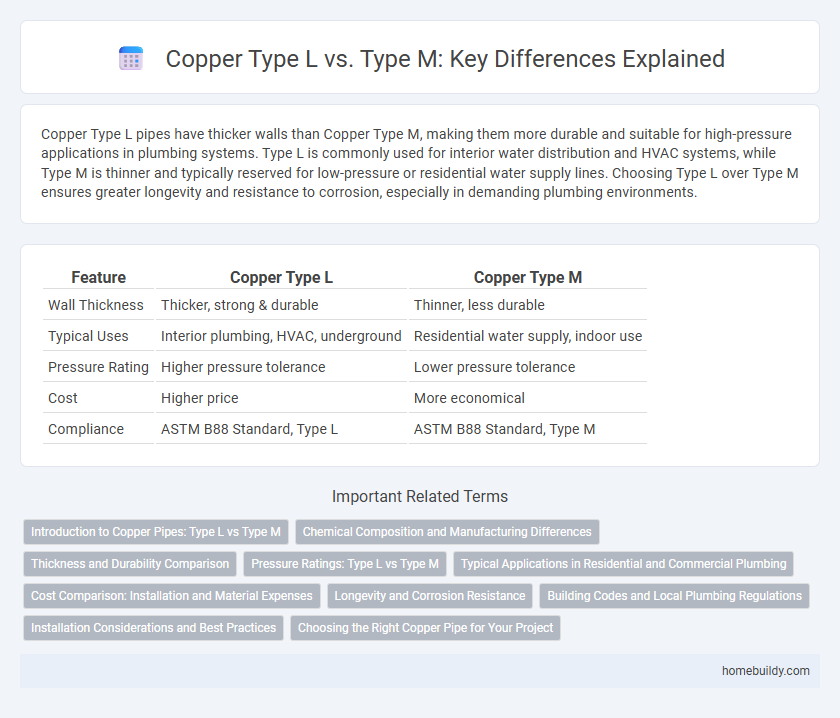Copper Type L pipes have thicker walls than Copper Type M, making them more durable and suitable for high-pressure applications in plumbing systems. Type L is commonly used for interior water distribution and HVAC systems, while Type M is thinner and typically reserved for low-pressure or residential water supply lines. Choosing Type L over Type M ensures greater longevity and resistance to corrosion, especially in demanding plumbing environments.
Table of Comparison
| Feature | Copper Type L | Copper Type M |
|---|---|---|
| Wall Thickness | Thicker, strong & durable | Thinner, less durable |
| Typical Uses | Interior plumbing, HVAC, underground | Residential water supply, indoor use |
| Pressure Rating | Higher pressure tolerance | Lower pressure tolerance |
| Cost | Higher price | More economical |
| Compliance | ASTM B88 Standard, Type L | ASTM B88 Standard, Type M |
Introduction to Copper Pipes: Type L vs Type M
Copper Type L pipes feature medium wall thickness suitable for residential water distribution, offering durability and corrosion resistance. Copper Type M pipes have thinner walls designed primarily for low-pressure applications such as drainage and heating systems. Selecting between Type L and Type M depends on specific plumbing requirements, including water pressure and system longevity.
Chemical Composition and Manufacturing Differences
Copper Type L and Copper Type M pipes differ primarily in wall thickness, impacting corrosion resistance and durability in plumbing applications. Type L has a thicker wall, produced through a controlled casting and annealing process resulting in enhanced strength and improved resistance to chemical corrosion. Both types utilize high-purity copper with similar chemical compositions, mainly composed of 99.9% copper, but Type L's manufacturing specifications ensure stricter quality controls for increased longevity in water supply systems.
Thickness and Durability Comparison
Copper Type L pipes feature a thicker wall compared to Copper Type M, providing enhanced durability and resistance to pressure. Type L's increased thickness makes it suitable for interior plumbing, heating, and fire protection systems where longevity and strength are critical. Conversely, Copper Type M's thinner walls result in lighter weight and lower cost but reduced durability, best suited for low-pressure applications.
Pressure Ratings: Type L vs Type M
Copper Type L pipes have a thicker wall compared to Type M, resulting in higher pressure ratings suitable for both residential and commercial plumbing applications. Type L typically handles pressures up to 400 psi, while Type M is rated for lower pressures, around 200 psi, making it ideal for low-pressure water distribution. Choosing Type L ensures greater durability and safety in systems exposed to higher water pressure or temperature fluctuations.
Typical Applications in Residential and Commercial Plumbing
Copper Type L pipes are commonly used in both residential and commercial plumbing systems for water supply lines, fire sprinkler systems, and HVAC applications due to their medium thickness and durability. Copper Type M pipes, being thinner and less expensive, are typically found in residential water distribution where lower pressure ratings are acceptable. Both types offer excellent corrosion resistance, but Type L's added thickness makes it more suitable for exposed or high-pressure installations.
Cost Comparison: Installation and Material Expenses
Copper Type L pipes generally cost more than Copper Type M due to thicker walls providing enhanced durability and corrosion resistance. Installation expenses for Type L are often higher because its rigidity requires specialized tools and more labor time compared to the thinner, more flexible Type M pipes. Material costs for Type M are lower, making it a budget-friendly option for non-critical applications where pressure and durability demands are minimal.
Longevity and Corrosion Resistance
Copper Type L pipes offer superior longevity and corrosion resistance compared to Copper Type M due to their thicker walls, making them ideal for both interior and exterior plumbing applications. The increased wall thickness in Type L enhances durability against wear, reducing the risk of leaks and pipe failure over time. Copper Type M, while more cost-effective, has thinner walls that may corrode faster in harsh water conditions, limiting its lifespan and reliability.
Building Codes and Local Plumbing Regulations
Copper Type L and Copper Type M pipes differ primarily in wall thickness, impacting their compliance with specific building codes and local plumbing regulations. Type L, with thicker walls, is often required for interior water supply lines in residential and commercial buildings, especially where higher pressure ratings and durability are mandated by plumbing codes like the IPC and UPC. Local regulations may restrict Type M's usage to lower-pressure applications such as residential drainage or non-potable systems due to its thinner walls and lower pressure tolerance.
Installation Considerations and Best Practices
Copper Type L pipe offers thicker walls than Type M, providing enhanced durability for water supply and HVAC systems, especially where higher pressure or mechanical stress is expected. Installation practices emphasize careful cutting with a tubing cutter, thorough deburring to prevent internal damage, and proper flaring or soldering techniques to ensure leak-free joints. Choosing between Type L and Type M should factor in local building codes, water pressure requirements, and potential environmental exposure to optimize performance and longevity.
Choosing the Right Copper Pipe for Your Project
Copper Type L piping offers a thicker wall than Type M, making it more suitable for high-pressure plumbing applications and heating systems. Type M copper pipe, being thinner and more affordable, is ideal for residential water supply lines with lower pressure requirements. Selecting the right copper pipe depends on factors like water pressure, building codes, and budget constraints to ensure durability and performance.
Copper Type L vs Copper Type M Infographic

 homebuildy.com
homebuildy.com